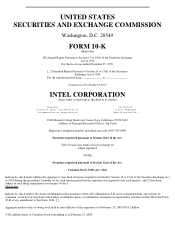Intel 1999 Annual Report Download - page 9
Download and view the complete annual report
Please find page 9 of the 1999 Intel annual report below. You can navigate through the pages in the report by either clicking on the pages listed below, or by using the keyword search tool below to find specific information within the annual report.Intel also continued to introduce new members of a family of networking interface cards based on the multi-platform, single-chip Fast Ethernet
controller, the Intel(R) 82559. Featuring Intel(R) SingleDriver technology, these new adapters are designed to lower network support costs and
complexity by providing a common set of software drivers for servers, desktops, network PCs and mobile clients. Ethernet refers to a local
network used to transfer information at 10 million bits per second, while Fast Ethernet networks transfer information at 100 million bits per
second. In January 2000, Intel announced its new family of Intel(R) PRO/100 S network security-enabled adapters, which help enable higher
performance and end-to-end security within the LAN.
In January 2000, the company announced the Intel PRO/DSL 3100 Modem. Its predecessor, the Intel(R) PRO/DSL 2100 Modem was
introduced in the fourth quarter of 1999. Both modems are based on two new industry standards that allow access to the Internet at speeds up to
150 times faster than the fastest analog modems.
In November 1999, the company introduced a higher performance version of its Intel(R) AnyPoint(TM) Phoneline Home Network product that
allows families to connect multiple PCs within a single home with bandwidth of up to 10 million bits per second over existing phone lines.
EMBEDDED CONTROL PRODUCTS. Intel's embedded control products include a range of components used to control functions in
networking and communications applications, such as telecommunications, hubs, routers and wide area networking. Intel's embedded control
chips are also used in laser printers, imaging, storage media, point-of-sale systems, industrial automation equipment, automotive systems and
other applications. Products include low-power- consumption versions of the Pentium processor with MMX technology and the 32-bit i960(R)
reduced instruction set computing (RISC) processor with integrated input/output capabilities. Additional products include microcontrollers of
the Intel(R) MCS(R)-51 and MCS(R)-296 microcontroller families.
In February 1999, Intel introduced Celeron processors running at 300 and 366 MHz into the embedded product line. In May 1999, Intel
announced the addition of the low-power-consumption Pentium II processors running at 266 and 333 MHz as well as the Celeron processor
running at 433 MHz to its embedded product line. In February 2000, low-power-consumption Pentium III processors running at 400 and 500
MHz as well as the Pentium III processor running at 600 MHz were made available for embedded products aimed at new networking and
communications, point-of-sale and industrial automation equipment applications.
Communications Products Group
The Communications Products Group (CPG) provides system-level hardware, software and support services for e-Business data centers and
building blocks for communications access solutions. These products include hubs, routers and switches for Ethernet and Fast Ethernet
networks, e-
Commerce infrastructure appliances and computer telephony components. Computer telephony is a term used to encompass a wide
variety of technologies and applications that use the information processing capabilities of a computer, often a server, to add intelligence to
telephone functions and to combine these functions with data processing.
In February 1999, Intel acquired Shiva Corporation to expand Intel's networking product line with remote access and virtual private networking
(VPN) solutions for the small to medium enterprise market segment and the remote needs of campuses and branch offices.
In July 1999, Intel acquired Dialogic Corporation, a maker of computer telephony hardware and software. The acquisition is aimed at
expanding Intel's standard- high-volume (SHV) server business in the networking and telecommunications market segment by providing
standards-based hardware and software building blocks for integrated voice and data networks. Dialogic's hardware products receive and
process signals from telecommunications networks and perform computing functions to convert the signals to data (and vice versa) appropriate
for computer systems. These computing functions are based upon algorithms for a variety of features, including voice compression and
decompression, voice storage, speech recognition, tone recognition and signaling, and facsimile compression and generation. Dialogic
hardware products are provided bundled with software elements, such as drivers, which enable the hardware products to work in the host
environment and to be compatible with other elements within the system in which they are installed.
6






















